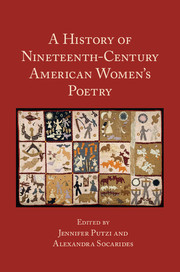Book contents
- Frontmatter
- Contents
- List of Illustrations
- List of Contributors
- Acknowledgments
- Introduction: Making History: Thinking about Nineteenth-Century American Women's Poetry
- PART I 1800–1840, AMERICAN POESIS AND THE NATIONAL IMAGINARY
- PART II 1840–1865, UNIONS AND DISUNIONS
- PART III 1865–1900, EXPERIMENT AND EXPANSION
- 17 Women Poets and American Literary Realism
- 18 Verse Forms
- 19 Braided Relations: Toward a History of Nineteenth-Century American Indian Women's Poetry
- 20 Frances Harper and the Poetry of Reconstruction
- 21 “hear the bird”: Sarah Piatt and the Dramatic Monologue
- 22 Women Writers and the Hymn
- 23 Women Poets, Child Readers
- 24 Emma Lazarus Transnational
- 25 The Creation of Emily Dickinson and the Study of Nineteenth-Century American Women's Poetry
- Suggested Further Reading
- Index
17 - Women Poets and American Literary Realism
from PART III - 1865–1900, EXPERIMENT AND EXPANSION
Published online by Cambridge University Press: 21 January 2017
- Frontmatter
- Contents
- List of Illustrations
- List of Contributors
- Acknowledgments
- Introduction: Making History: Thinking about Nineteenth-Century American Women's Poetry
- PART I 1800–1840, AMERICAN POESIS AND THE NATIONAL IMAGINARY
- PART II 1840–1865, UNIONS AND DISUNIONS
- PART III 1865–1900, EXPERIMENT AND EXPANSION
- 17 Women Poets and American Literary Realism
- 18 Verse Forms
- 19 Braided Relations: Toward a History of Nineteenth-Century American Indian Women's Poetry
- 20 Frances Harper and the Poetry of Reconstruction
- 21 “hear the bird”: Sarah Piatt and the Dramatic Monologue
- 22 Women Writers and the Hymn
- 23 Women Poets, Child Readers
- 24 Emma Lazarus Transnational
- 25 The Creation of Emily Dickinson and the Study of Nineteenth-Century American Women's Poetry
- Suggested Further Reading
- Index
Summary
American literary histories have long presented realism as the “major” or “great movement” of the postbellum period. According to this narrative, William Dean Howells, Henry James, and Mark Twain towered over the era as its “major realists,” with the year 1885 standing as the “annus mirabilis” that saw the publication of The Rise of Silas Lapham, The Bostonians (serialized that year in The Century Magazine), and Adventures of Huckleberry Finn. (Designating 1885 to be “a year of wonders” itself speaks to the chronological exceptionalism that undergirds this narrative.) In more recent decades, scholarship has turned to extending the story of realism backward in time (e.g., to Rebecca Harding Davis) and simultaneously to expanding its canon to include a more diverse array of writers, including women (especially regionalists such as Sarah Orne Jewett and Mary E. Wilkins Freeman) and writers of color (such as Zitkala-Ŝa). Nevertheless, realism has remained a mostly genre-exclusive conception that leaves poetry out of the story. My argument here breaks with the long scholarly tradition of dissociating poetry from realism. I argue that an active strain of realist writing not only by women, but by women poets in particular, evolved in the decades following the Civil War. Common in print culture by the 1870s, women's realist poems helped to shape the literary climate for the later and better-known projects of their fellow realists working in fiction.
The term “realism” is one of the most troubled keywords in American literary history, rendering terminological ground-clearing especially necessary. Michael Davitt Bell argues that the term “realism,” both during the postbellum era and in twentieth-century scholarship about it, is consistently plagued by problems of definition. Nancy Glazener demonstrates that culturally authoritative magazines promoted “realism” as a literary quality that readers should “read for,” even though any precise definition remained slippery at best. For present purposes, I adopt a necessarily brief working gloss that incorporates key points of consensus in both postbellum discourses and in twentieth-century scholarship: realism is a mode of literary writing that seeks to represent contemporary social reality in a way that entails accurate observations of commonplace events, characters, and settings and that does so without recourse to transcendental frames of reference as a foundation. I present a selected group of realist poems by four women, published between 1872 and 1889.
- Type
- Chapter
- Information
- A History of Nineteenth-Century American Women's Poetry , pp. 283 - 297Publisher: Cambridge University PressPrint publication year: 2016



